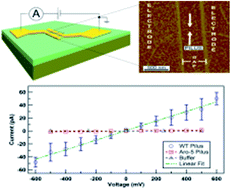Conductivity of individual Geobacter pili†
Abstract
The electrically conductive pili of Geobacter species have been proposed to play an important role in long-range electron transfer to Fe(III) oxides and other cells and have potential as a sustainable source of electrically conductive materials. Surprisingly, there have been no previous reports on the actual conductivity of individual pili, probably the most important parameter for evaluating mechanistic models of electron transport and pili function. Therefore, the conductivity of individual pili of Geobacter sulfureducens was measured with a low-noise nano-electrode measurement platform along regions of the pili that appeared to be cytochrome-free. Pilus conductivity was highly dependent upon pH with conductivity estimates of 188 ± 34 mS cm−1, 51 ± 19 mS cm−1, and 37 ± 15 μS cm−1 at pH 2, 7, and 10.5, respectively. The conductivities of pili from strain Aro-5, which expresses pili in which an alanine was substituted for each of five aromatic amino acids, were significantly lower than the wild-type pili. These results, and the previous finding that stacking of aromatic amino acids increases at low pH, suggest that aromatic amino acids play a key role in pilus conductivity. The conductivity of the G. sulfurreducens pili is comparable to conducting organic polymer wires of similar diameter and several bacterial filaments of substantially different composition. These results provide important parameters that should be accommodated in future models of G. sulfurreducens pilus conductivity and suggest strategies for enhancing pilus conductivity with genetic manipulation.


 Please wait while we load your content...
Please wait while we load your content...